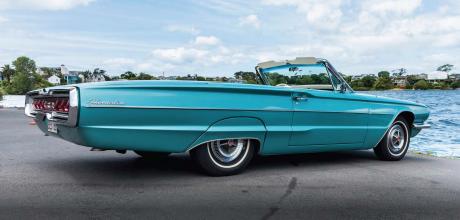1966 Ford Thunderbird 390 Convertible
The convertible is a perfect expression of one version of the American dream and, for a lucky few, dreams do come true.
By Ian Parkes, photography by High Art Photography
THE AMERICAN DREAM
The Ford Thunderbird. The name has a music that is just so evocative of all that is good and pure about the golden era of the American automobile.
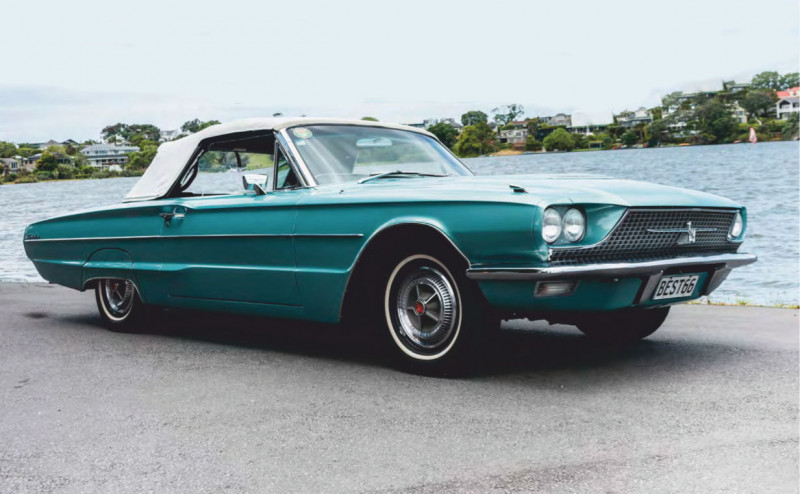
While for many people the name will conjure up images of the cars first, they were actually named after an ancient North American mythical creature that created both thunder with a clap of its wings, and indeed, most of the physical world. That soaring eagle imagery is surely another reason that the Thunderbird resonates so deeply with both American culture and the landscape.
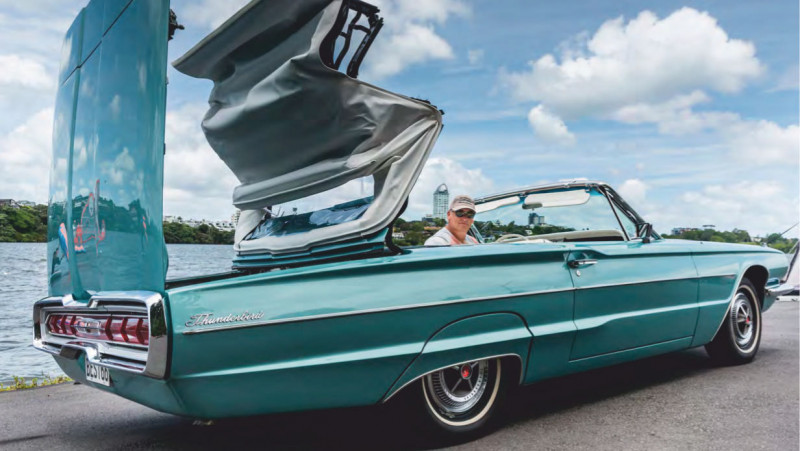
Despite the legacy of freeway congestion and smog that was dawning in the ’60s, the dream of endless freedom of the highway still burned strong — and Ford created a car that remains today the best way to live that dream — in the expansive comfort of a convertible Thunderbird. Looking back, it’s obvious that Ford was right to move away from the original T-Bird concept of an American sports car to add two more seats and luxury touches, like an electric folding hood, electric windows, door locks, seats, mirrors, and multiple ashtrays.
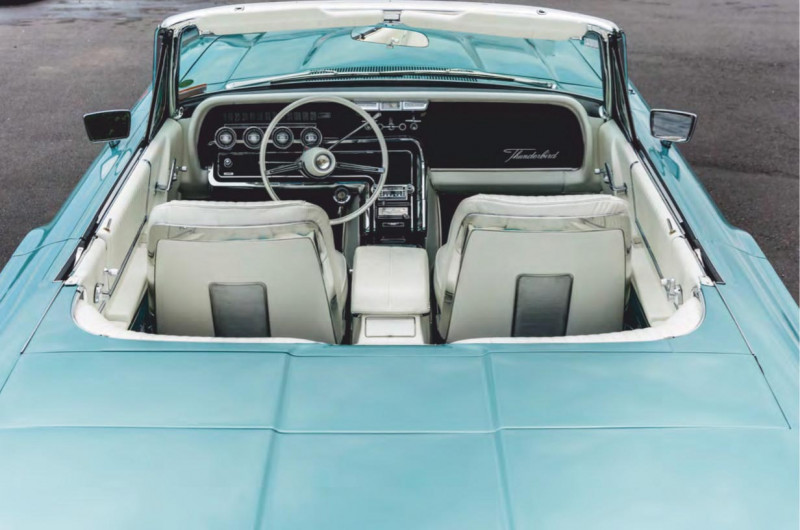
The long straight highways in both the mind’s eye and reality didn’t need European sports car handling. They needed a lazy V8, silky suspension, and a decent expanse of metal around the cockpit so that the occupants didn’t feel too insignificant in the vastness of the Midwestern deserts.
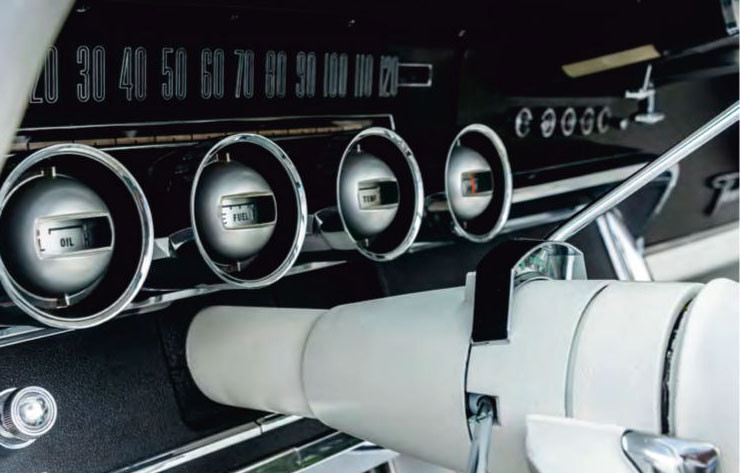
The car that we see here is the fourth generation of the T-Bird that so perfectly crystalises all the elements of the American road trip. It is no accident that the producers of the film Thelma & Louise settled on the ’66 T-Bird as both the symbolic and actual vehicle for the pair’s ultimate romantic escape into (spoiler alert) oblivion.
AVIAN EVOLUTION
The first generation, nattily nicknamed the 1955 ‘Early Bird’, also the ‘Baby Bird’, was too much of a sports car for the dreamlike quality needed. The second-generation Square Bird was a bit too heavy and down in the mouth, even though it won the Motor Trend Car of the Year crown.
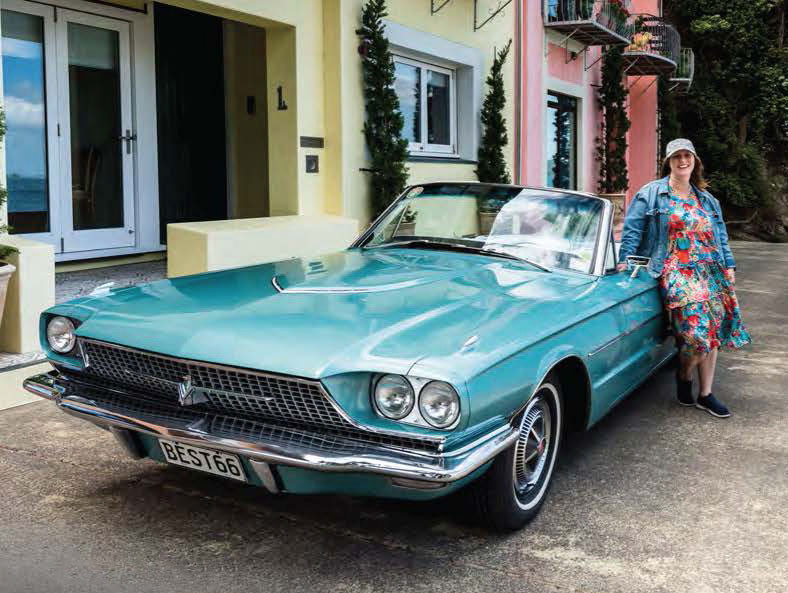
The sleek third-generation Bullet Bird, styled by Bill Boyer, might have been a fit but, like the first generation, the art director probably thought that it was a little too purposeful, especially when compared with the fourth generation. The fourth generation, the Flair Bird, styled by L David Ash and Art Querfeld, was just right. It was built on the same basic platform as the third generation but the lines were drawn out and the sculpting more refined, making it look lighter and more elegant, although it was actually considerably heavier. The larger expanse of flat panels connected it more strongly with the ’60s-era styling that both Thelma and Louise adored. It was the dream machine for Thelma, Louise — and Sarah Kneebone in Auckland, who owns this particular car.
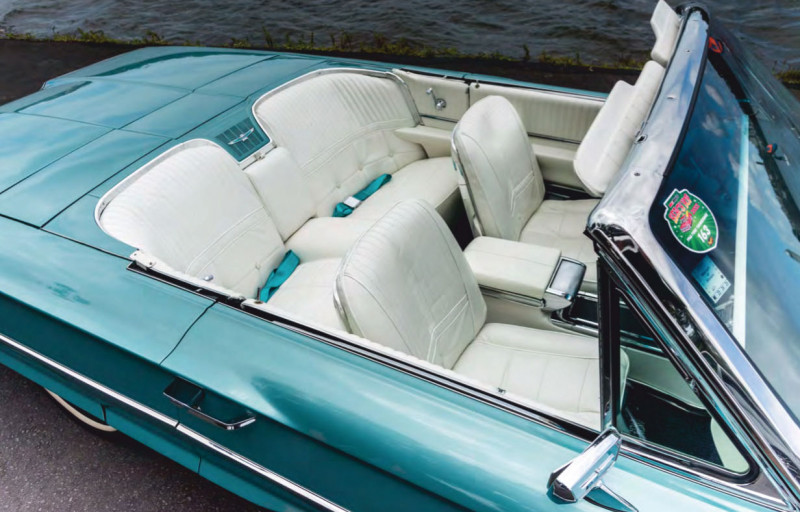
Some people find it hard to settle on one car as their favourite but, for Sarah, it was easy. She was familiar with and liked a few American cars and convertibles but when she saw Thelma & Louise, she fell for the ’66 T-Bird hard, and for good. It wasn’t like she had to have one right away, but it was satisfying to hold that car as the ideal and she could see it in the film, any time she wanted — which she did, quite often. Sarah has seen the film at least 10 times.
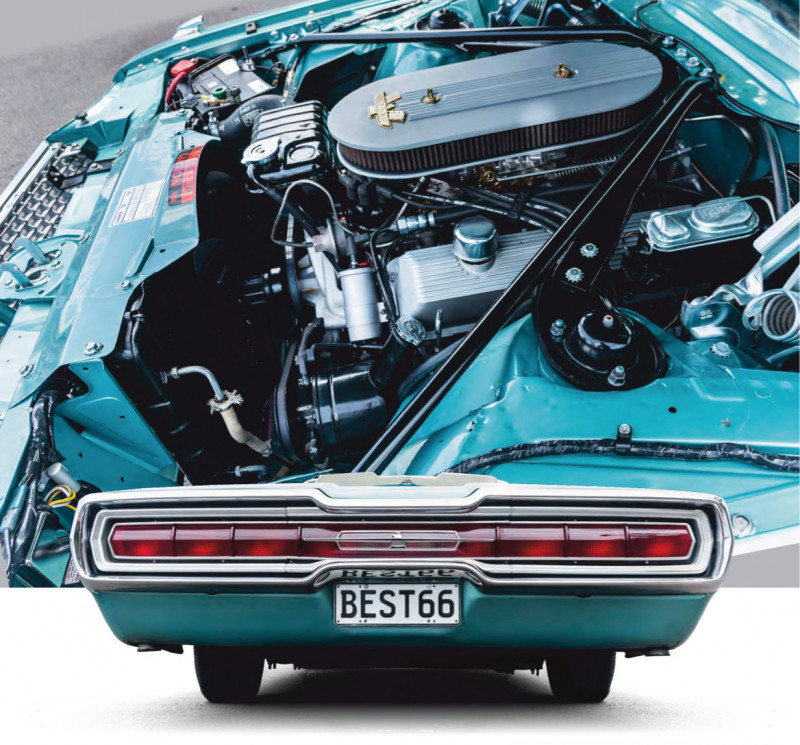
Fortunately, her partner Nick Ray is a car guy and is of a practical bent. He already owned a 2016 Dodge Challenger Hellcat, which they have put to good use on both track and drag strip. He had also spent some time building his own dream car, the 1969 Dodge Charger, known as the ‘General Lee’, the real star of the TV series The Dukes of Hazzard. We featured that car in Issue No. 377 of New Zealand Classic Car last year. We also detailed the challenges that Nick faced in producing a faithful replica after so many original ’69 Chargers were wrecked that the TV production company started modifying cars from other years to feed into the cycle of destruction.
SCREEN MAGIC
So, after Nick had finished that car and geared himself up for another project, he asked Sarah — if she was also ready to endure another car project — what she thought it should be. The answer wasn’t long in coming: a ’66 Thunderbird, of course. But not just any ’66. It should be a convertible, and in the same metallic blue-green with white interior as per Louise’s car. “I’ve always admired the film and completely loved the car, and loved the whole idea of cruising in a car like that, and being on an adventure,” says Sarah. “Whenever I saw one I’d always point it out and say ‘that was a ’66’. Nick said, ‘If that’s your dream, we should make it happen’.”
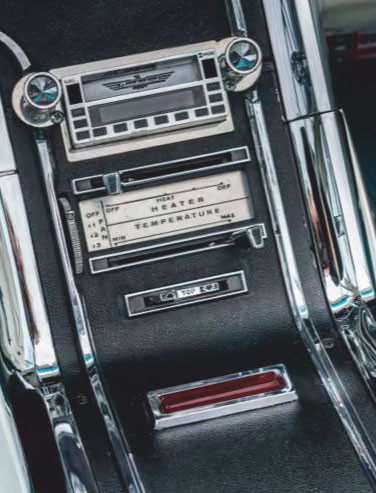
It was an irresistible project with a neat symmetry. Nick’s car is a famous hero car from the small screen and Sarah’s car, from just a couple of years earlier, was also a bona fide star of the silver screen.
Nick, along with friend Neil Anthony from Phoenix Audio NZ in Rotorua, started researching cars for sale in the US and it wasn’t long before they both came across a strong contender for sale at a car dealer’s in Iowa. While Nick and Sarah couldn’t justify a trip to the States, the dealer answered dozens of questions and supplied lots of photos, which helped reassure Nick that it was basically sound. There was a bit of rust in front of the rear wheels but that supported the view that its otherwise good condition was genuine.
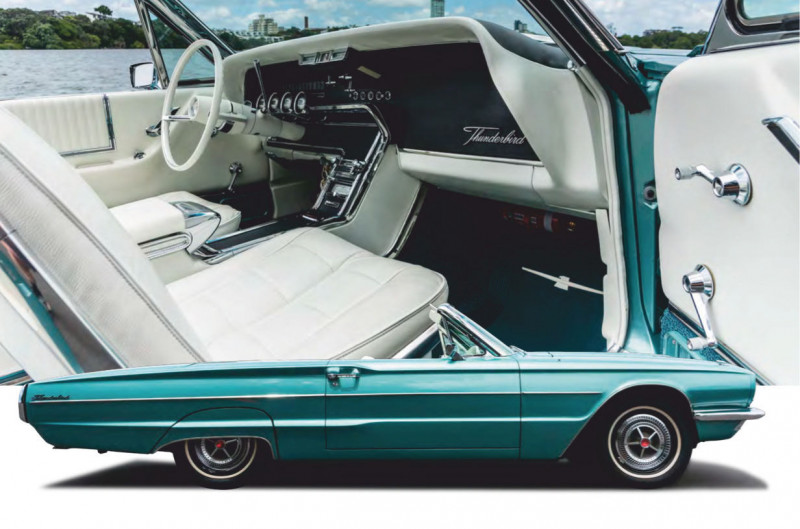
It was dark green, had been repainted about 10–12 years previously, and with a black vinyl interior, but that didn’t matter; the colour was always going to be changed anyway. Sarah says that plenty of people offered the view they were mad to consider changing the colour or even attempting a restoration but Nick and Sarah decided to go for it.
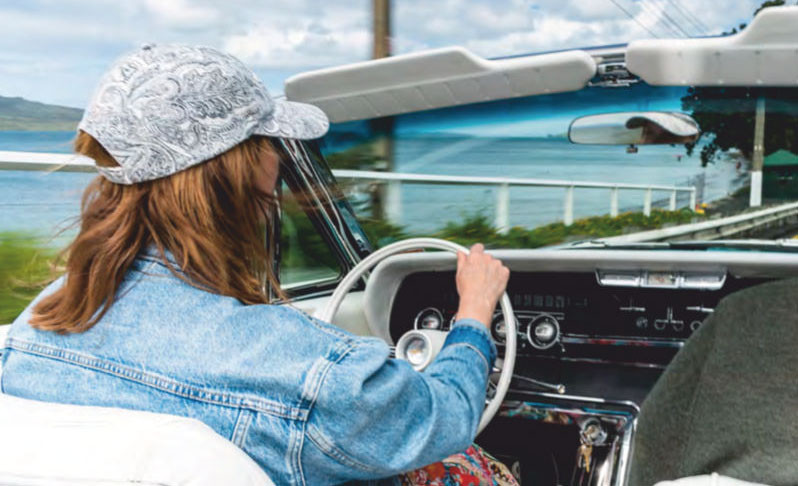
The Patrician Green of the Thelma and Louise car was a genuine Ford colour but it wasn’t offered for the ’66 T-Bird, and, as Nick always intended to do a full bare-metal rebuild, the original colour was irrelevant. The Petersen Automotive Museum in the US had an original car from the movie and Nick contacted them to get as much information about it as possible. He says that they were extremely helpful.
When the car arrived, Sarah and Nick were pleased to see that it was well and truly sound enough to be driven. “As soon as the car came off the ship in Tauranga we drove it to Rotorua and I drove it from there. It was really good and quite surreal,” says Sarah. “This was a dream that was actually coming true — something I thought could never happen. And yes, we definitely had the roof down, even though it rained a bit while we were driving but did we care? Not a bit!”
UNDER THE SKIN
As you’d expect from a 56-year-old car, it had picked up a couple of knocks but the biggest issues were with the foldaway soft-top. The panel that flips out of the boot to tidy up the rear deck when the soft-top is down was “a bit lacey”, and the large boot panel had a kink in it. Nick says that the boot lid had apparently been activated without releasing the catches holding the hood to the top of the windscreen, which meant the hydraulic rams simply carried on and bent the large panel.
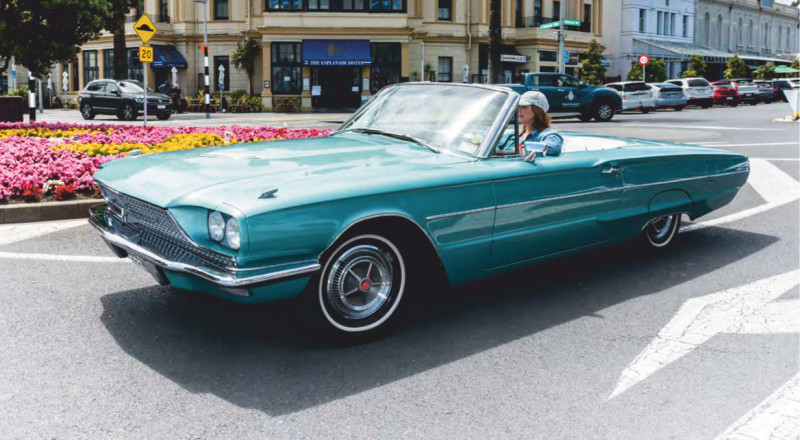
Nick decided to get the panels rebuilt rather than risk buying expensive second-hand panels, which, anyway, were extremely hard to find. “It cost a lot but they were the original ones and it was definitely worth it,” he says. Getting the body back to bare metal was a delicate process. Nick and Sarah entrusted the work to Darryl Stein at Dustless Blasting Counties. He was so concerned that media blasting such large panels could distort the metal that he ran a number of tests to make sure that didn’t happen. The stunning lustrous paintwork was applied by Andrew Wezenbeek at Whenuapai Auto Refinish. Nick highly recommends Andrew for his attention to detail and fair pricing.
The standard 390-cubic-inch (ci) (6.4-litre) FE engine was reconditioned by Taylor Automotive but both Nick and Sarah wanted all the internals to be exactly as standard. They agreed with Ford that performance wasn’t the goal here and the 11-second 0–60mph (0–97kph) performance of this car was fine with them. For those who wanted a faster ’Bird, the new seven-litre 428ci (seven-litre) V8 became an option that year. It was rated at 345 horsepower (hp; 257kW), up from the standard engine’s 315hp (235kW), reducing the 0–60mph time to about nine seconds.
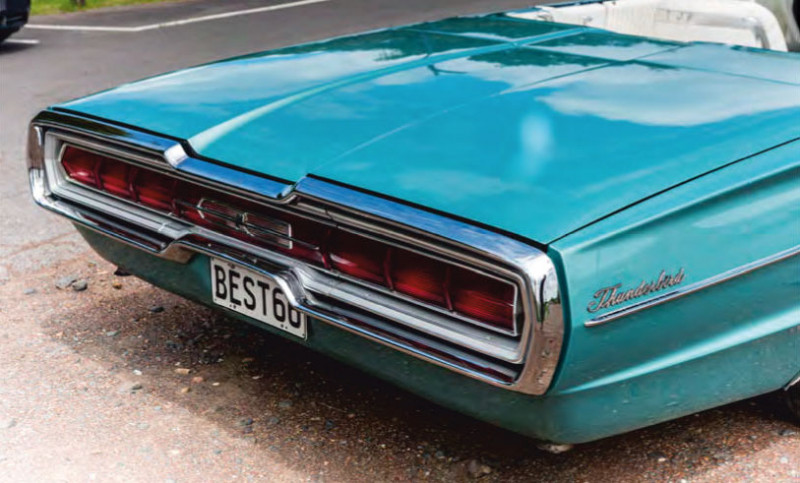
Nick replaced all the rubbers and chrome trim. The car came with disc brakes — they were made standard the previous year — but Nick added a better master cylinder and brake booster. He also chose to fit a more modern carb, and a factory Mustang GT500 air cleaner, modified slightly.
Nick also stuck with the C6 transmission, which was introduced in 1966 for Ford trucks and its more powerful cars. It was also known as the ‘SelectShift Cruise-O-Matic’, because it would hold first or second gear when they were selected. It was simpler and lighter but it also handled more torque with lower losses than the previous MX design. The upside of Covid was that Nick had plenty of time in which to fully disassemble the car, check every piece to ensure that it was up to scratch, and find new-old-stock replacement parts via the internet where possible.
He says that there is quite an industry now remanufacturing parts for old T-Birds and there are a couple of specialist suppliers in the US but not everything is available. One of the things he was pleased to find in good condition on this car were the chrome bumpers, as they are unique to the ’66 model. “Nick has spent hours and hours and hours working on it,” says Sarah. He definitely loves it too.”
SOFT-TOP HARD
One of the most challenging jobs, which placed the project in an altogether different category to most classic car rebuilds, was refurbishing the electric and hydraulic powered soft-top mechanism, reassembling it, fitting the new hood, and getting it all to work. “It took me two solid weeks just to get it back together,” says Nick, “And it drove me nuts.”
While it might appear that the 1966 Thunderbird was from the heyday of convertibles, in reality convertibles were on their way out. Sales of the third-generation convertibles were already down on previous generations, accounting for less than one in 10 of the cars sold in that model’s last year, 1963. The ’66 was the last T-Bird to be offered as a convertible until the retro 11th generation, which echoed the looks of the first-generation cars, was launched in 2002.
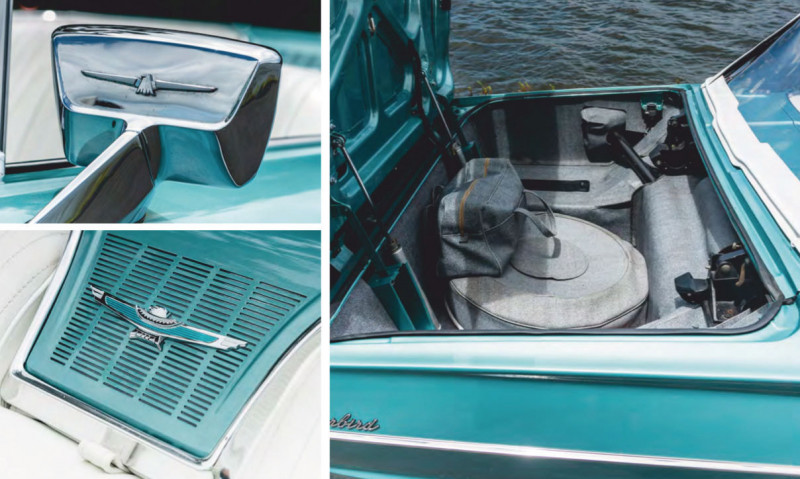
The operation of the soft-top is a marvel to behold, especially considering its age. It actually appeared on the second-generation T-Bird in 1958 but dated back to an earlier Ford Skyliner.
While it considerably restricts the boot space, as the roof and the mechanism fold down into it, it’s vastly more sophisticated than the usual manual squash-down affair that ruins the lines of most British convertibles of the time. The boot lid is rear hinged and raised and lowered by electrically operated hydraulic cylinders. When lowering the soft-top, the boot lid cranks open first and a flip panel tucked under the forward end of the boot lid folds out. The roof concertinas and rotates backwards into the boot. The lid then closes, the extra panel at its leading edge covering the gap between the boot lid and the back of the rear seats. The lids then motor down tight. There’s no need for a separate soft cover to be buttoned over the roof bows because everything is tucked away in the boot.
Wikipedia drily notes, “This design could present challenges for troubleshooting a convertible top malfunction. The system consists of solenoids, relays, limit switches, electric motors, and a hydraulic pump/ reservoir, as well as several hydraulic directional valves and cylinders. While the hydraulic system is not often a cause for trouble, electrical relays are known to fail. Malfunction of any of the numerous relays, motors, or limit switches prevents the convertible system from completing the cycle.”
Getting all of this apart to recondition and repaint it and getting it all back together again in working condition is testament to Nick’s skill and dedication.
He has also partially rewired the car and upgraded the lights. “There are 50- odd lights in this car and I’ve changed them all to LEDs except the rear stop lights and indicators,” he says.
The ’65 and ’66 feature sequential indicators, the turn signal illuminating first one, then two, then three bulbs in the rear lamp unit. This was due to be introduced in 1964 but apparently had to be delayed until regulators were convinced the novelty wasn’t dangerous. That sequential repeater wouldn’t work with LEDs, so Nick stuck with the original incandescent bulbs. Perhaps it’s for the best, as the glow and fade of the original bulbs looks more in keeping with sequencing than the abrupt brilliance of LEDs.
LUXURY LOOK
The interior of the car is just as exquisite as the outside, especially in the white leather that Nick and Sarah sourced as a complete upholstery kit. That sounds straightforward enough but anyone who has ever attempted to fit an upholstery kit — even a topquality one like this — knows that Nick had a fight on his hands. Never again, says Nick.
The doors’ interior panels were damaged and the replicas did not look too good, so sending the old ones to Dashboard Restorations for recovering was the only option. One of the downsides of this approach is that the extra material would make the door cards bigger, so they would no longer fit quite right. This meant some subtle modifications had to be planned and made to achieve the standard of finish that Nick and Sarah had set for themselves.
Nick sourced more of the originalstyle speaker covers to fit four additional speakers around the interior. “It’s got to have a kick-ass stereo too,” Sarah told Nick. He says that was one of her more emphatic requests. A RetroRadio currently resides in the dash but this is a temporary fixture to fill the hole while a modern stereo is being built inside the original radio’s chassis.
People raised to believe that a polished walnut dashboard is the touchstone of a luxury interior might take a few moments to recalibrate when behind the wheel of a ’66 Thunderbird. Surely the sheer depth of the different planes of the dashboard, the sculpting of the gauges and aircraft-style switches, and the play of light on the painted metal and chrome are much more indicative of indulgent luxury than a slab of wood?
And surely with options like cruise control; central locking; a power aerial; electric controls for the windows, seats, mirrors; and that extraordinary soft-top provide confirmation. No? OK, then let the Swing Away steering wheel be the final word. Place the transmission in park and suddenly the left-sidemounted steering wheel is free to slide approximately 460mm to the right, giving the driver even more room to exit the vehicle gracefully. “It would be nice to have air-con but you don’t really need it in a convertible,” says Nick. And it would probably mess up the lovely-looking engine bay. Nick says that all the time he has spent on the T-Bird has given him a special appreciation of “what a cool and individual car the Flair Bird really is”. Although he wouldn’t do another one. Not a rebuild anyway.
BEST IN SHOW
The ’66 T-Bird was the ultimate expression of Ford’s personal luxury car. It was easily the most expensive Ford and actually cost more than the Buick Riviera that Ford had introduced specifically to be a luxury coup… And as Ford’s own new Mustang was already nibbling away at T-Bird sales, the follow-up fifth-generation car was pushed upmarket to become a bigger, old-school, body-on-chassis car. It was also offered as a four-door family saloon.
“It is real luxury,” asserts Sarah. “You get in it and you just cruise; you can’t help yourself.”
“It’s much nicer to drive than my car,” says Nick of his Charger, although it’s surely nice to have the choice. The one downside of a family outing in early summer was that they forgot to tool up with sunscreen and everyone got a bit sunburnt.
“We didn’t drive it again until it was fully restored,” says Sarah. The motor had to be run in, so it was very much like driving a brand-new car.
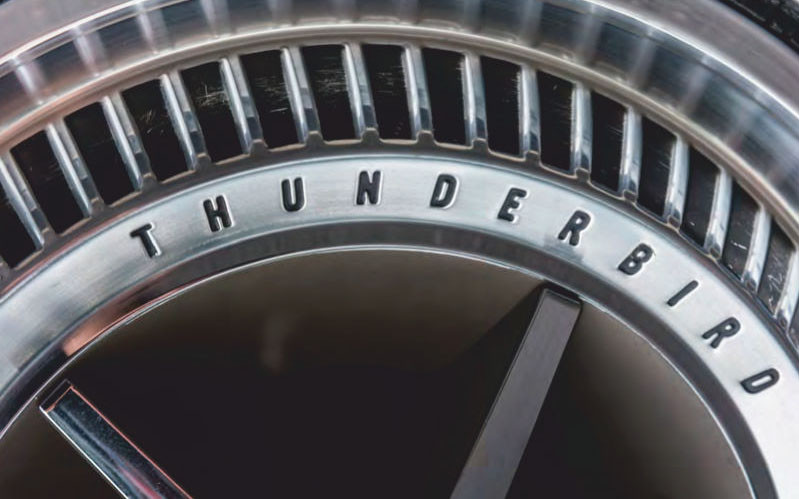
They also took it on its debut visit to Repco Beach Hop 2022, which was held in November last year. Sarah says that T-Birds aren’t really ‘the thing’ at the Beach Hop, where wilder and more spectacular cars get the most attention, but as the convertible was the theme being celebrated at the first post-Covid hop, they got to drive the car at the front of one of the parades.
“Numerous times, as we were driving through the crowd, you could hear people saying ‘love that car’ and ‘what a beautiful car’. We heard it time and time again: ‘what a beautiful car’,” says Sarah.
“All the people we knew were congratulating us and acknowledging how much work Nick has put into this. “It truly is a dream come true.”
If a final stamp of approval was even needed, the car was also a hit with another discerning crowd. It picked up the People’s Choice award at last year’s Ford Thunderbird Owners Club of NZ annual convention, held over Labour
weekend in Tauranga.
The ’1966 T-Bird was the ultimate personal luxury car. It even cost more than the Buick Riviera that Ford had introduced specifically to be a luxury coup.
Never forget that it’s a Thunderbird Boot space is reasonable — when the soft-top isn’t in it
The roof and the mechanism fold down seamlessly into the boot. It’s vastly more sophisticated than the manual squashdown affair that ruins the lines of most British convertibles of the time Sixties jet-age rear cowl and sequential indicator lights make one of the world's best rear ends Thelma? Louise? Sarah, actually
Darryl was so concerned that media blasting such large panels could distort the metal that he ran a number of tests first Individual club-style rear seats a sensation then and now
Hydroelectric soft-top: a joy to behold and a nightmare to restore
Deeply sculpted dials are flamboyant luxury touches
The Patrician Green of the Thelma & Louise car was a genuine Ford colour
Swing Away steering wheel in action
Every detail a delight.
Subtle rear three-quarter flares put previous ’50s-era rocket-style fins firmly in the past
The Flair Bird’s lines were drawn out and the sculpting more refined, making it look lighter and more elegant than the previous generation
TECHNICAL DATA 1966 Ford Thunderbird 390 Convertible
- Engine Ford FE series 90-degree V8 390
- Capacity 6.4-litre
- Bore/Stroke 102.87mm/96.01mm
- Valves Single overhead camshaft on 90-degree
- Compression 10.5:1
- Max Power 315bhp (235kW) at 4600rpm
- Max Torque 427 pound-foot (579Nm) at 2800rpm
- Fuel supply Ford 9510 four-barrel carburettor
- Transmission Ford C6 three-speed automatic
- Suspension, F/R Independent ball-joint and coilspring / Longitudinal leaf-spring and semifloating axle
- Steering Power-assisted
- Brakes, F/R Power-assisted disc / Drum
Dimensions
- Length 5217mm
- Width 1963mm
- Height 1334mm
- Wheelbase 2875mm
- Track, F/R 1549mm/1524mm
- Wheels 6.5Jx15
- Tyres 195/75R15
- Weight 2128kg
Performance
- Top speed 130mph (209kph)
- 0–60mph (0–97kph) 11 seconds
- Quarter-mile 16.6 seconds


